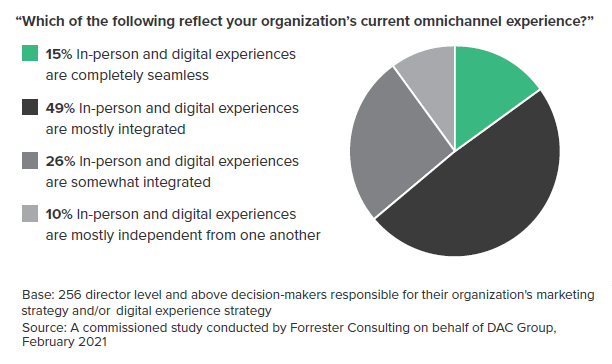
Navigate an unpredictable landscape with actionable, data-driven strategies tailored for your business from the brand down to the local level.

Omnichannel offers seamless, continuous customer experiences across online and offline touch points. If you get it right, you’ll drive both customer and financial growth. But if you get omnichannel wrong (or don’t bother at all), the opposite will be true: you’ll frustrate even your most loyal customers and erode your marketing ROI.
Although the stakes are higher than ever, omnichannel remains a highly misconstrued concept; a decade-long conversation with countless false starts and red herrings. That’s why we commissioned Forrester Consulting to dig a little deeper.
The resulting study, Create Competitive Differentiation By Integrating Your Digital And Physical Experiences, surveyed 256 marketing leaders (director-level and above) to assess the current and future state of omnichannel, explore the greatest challenges facing B2C brands, and reveal the key activities to bolster omnichannel success. These are our three key findings.
At the onset of the pandemic, we predicted that the new normal would be shaped by our collective efforts to adapt—commercially, culturally, and personally. That prediction has largely held true. The last 12 months have not only accelerated developments in logistics, ecommerce, and data analytics, but brought about a sea change in our attitudes towards home working and conscious capitalism.
The rate of change has been breathtaking, with an increasing number of organizations finally getting to grips with the concept of digital transformation. But make no mistake: the future will not be entirely online. Instead, our new normal demands both digital and in-person excellence. Look no further than the excitement generated by lockdown easing and the increasingly common sight of people delighting in simple physical experiences, from café lunches to long-overdue hair appointments.
By the same token, the most successful marketing strategies—today and in the years to come—will offer comprehensive omnichannel experiences through seamless digital and in-person interactions. The only problem? Let’s move on to the next point to find out…
Forrester found that only 15% of surveyed organizations have truly seamless omnichannel strategies. To put it bluntly, current approaches are stuck in the past as the majority of marketers continue to treat digital experiences and physical experiences as two distinct, disparate journeys.

At key stages of the customer journey, most brands are leveraging online or in-person tactics in isolation—never in coordination. Their process is stifled further by various technology and reporting deployments failing to connect with one another, undermining every effort to create cohesive customer experiences.
This trend varies widely by industry and by region. Just 8% of surveyed retailers, for instance, claim to offer completely seamless experiences compared to 25% of financial services organizations. Meanwhile, 19% of North American business leaders made the same claim compared to just 13% of their European counterparts. So the journey towards an omnichannel future will not be linear—but what, exactly, is holding us back? Forrester identified three main barriers:
Although many B2C organizations have abundant data sources at their disposal, they still struggle to derive actionable insights (85%), identify the right tools and technology (77%), and maintain unified customer profiles across channels (77%).
Consumers are forced to choose between digital and physical touch points across key stages of the lifecycle. Fewer than half of them—and, in some cases, just one-quarter—are able to seamlessly engage with brands both in-person and online. Such brands are aware this is happening, but don’t know how to start building cohesive experiences.
With most organizations deploying standalone silos for in-person and digital experiences, it’s no surprise that only one-third of respondents feel their key channels (website, social, app, paid search) are very effective at driving discovery of their products/services and acquiring new customers.
Subscribe to our monthly newsletter.
It’s not enough to offer experiences that only appear to be omnichannel without any of the joined-up thinking underneath. To drive meaningful growth, B2C organizations first have to capitalize on the renewed importance and appreciation of brick-and-mortar locations. Decision-makers know this all too well, with 75% of respondents acknowledging that their physical stores will be important or critical to overall business performance over the next three years.

For forward-thinking brands, this in-person renaissance is likely to include maximizing the value physical experiences can provide (e.g. interacting with a product and/or product expert), nurturing trust by investing in a local presence, and utilizing localized media for a more personalized touch.
Of course, location is only one aspect. As the study reveals in full, the most effective omnichannel strategies also prioritize data—quantitative and qualitative—and formalize efforts to generate actionable insights.
There’s no question that omnichannel creates complex challenges for most B2C businesses, and there’s no doubt that these challenges have to be faced sooner rather than later. In Forrester’s own words:
Brands must address the seamless [customer] experience now to remain profitable—but understanding where to start can be just as intimidating as addressing challenges.
So… what’s next? Start by downloading your free copy of the study, which includes a series of practical recommendations. For instance, investing now in different types of media is a great way to lay the foundations of a seamless strategy. Evaluate your current media and content (paid, owned, earned; from national to local) and re-imagine how you can blur the line between digital and physical in order to reach the right people with the right message at the right time.
With your insights in hand, revisit our omnichannel webinar with Jay Baer and Forrester’s Collin Colburn, then hit play on the omnichannel episode of Inside the Funnel, our podcast for marketing nerds, aficionados, and decision-makers. Finally, schedule a friendly chat with DAC, one of the world’s most significant Performance Marketing Agencies—and the authority on Enterprise-to-Local marketing.
Navigate an unpredictable landscape with actionable, data-driven strategies tailored for your business from the brand down to the local level.
Navigate an unpredictable landscape with actionable, data-driven strategies tailored for your business from the brand down to the local level.
Navigate an unpredictable landscape with actionable, data-driven strategies tailored for your business from the brand down to the local level.
Subscribe to our monthly newsletter.